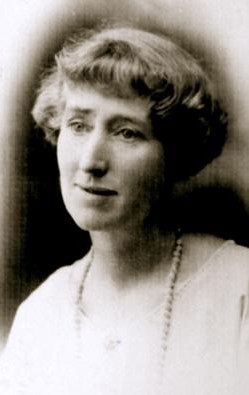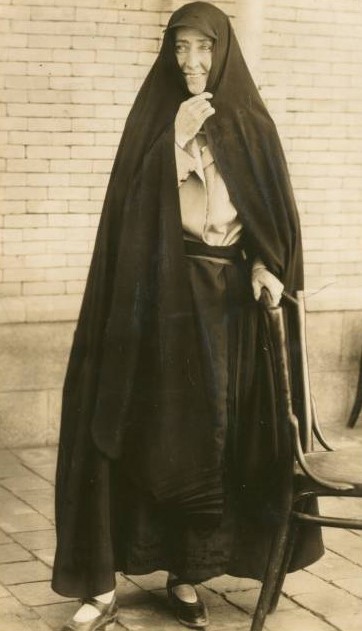EUPHEMIA ELEANOR BAKER

Born 25th March 1880 Goldsborough, Victoria
Died 2nd January 1968 - Waverley NSW
The following is from WIKIPEDIA, the free encyclopedia
Euphemia Eleanor Baker (aka Effie Baker) (1880–1968) was an Australian photographer, and follower and advocate of Baháʼí Faith. Initially she took pictures of Australian wildflowers and published them in a booklet form. Later, after becoming a follower of Baháʼí Faith in 1922, she took pictures of the Baháʼí monuments in Australia, New Zealand, Iraq and Persia, some of which were included in Shoghi Effendi's translation of the book The Dawn-Breakers. She became one of the Baháʼí Faith's notable photographers.
EARLY LIFE AND EDUCATION
Baker was born Euphemia Eleanor (Effie) Baker on 25th March 1880 at Goldsborough, Victoria. Her father was John Baker, a miner, and her mother was Margaret, née Smith; she was the eldest of their eleven children. When she moved in 1886 to Ballarat to live with her grandparents, her grandfather Henry Evans Baker, who worked as the first superintendent at the Ballarat Observatory, infused in her deep interest in scientific instruments, creative thinking, and evolution. She then took keen interest in acquiring knowledge of scientific photography. She studied at Clarendon School, Mount Pleasant State School, and Grenville College. She then studied at Ballarat East School of Art, followed by acquiring knowledge about colors and compositions at the Ballarat Fine Art Gallery's school under the guidance of P.M. Carew-Smyth. In 1892, she also learned to play piano under Edgar Nicolas, well known pianist, and gave piano performances at the Royal South Street Eisteddfod, and also won prizes.
PHOTOGRAPHER
In 1898, she developed her interest in photography in Perth and then at Ballarat in 1899; she started taking photographs with a quarter-plate camera which was given to her by her aunt Pheme (Henry Baker's sister). Initially, she made albums of these photographs and presented them to her parents. In 1900, she moved to Black Rock, Melbourne, and lived with her great aunt Euphemia, who was a headmistress and whose success influenced her. In 1914 she published a booklet of Australian Wild Flowers which contained seven hand-colored photographs taken by her. This booklet was republished in 1917, 1921, and 1922. She also made and sold fine wooden toys, made doll houses for charity, and painted water-colors of Australian flowers.
BAHÁʼÍ FAITH
In 1922, there was a major shift in her religious faith when she met Clara Dunn and John Henry Hyde Dunn, who were propagating the Baháʼí Faith that had been established in Persia during the nineteenth century. She attended their lecture on the Baháʼí Faith in Melbourne along with her friend Ruby Beaver. She was so strongly influenced by the teachings of this faith that she became a Baháʼí in 1922. She was the first woman who converted to this faith in Australia.
DOCUMENTING THE BAHÁʼÍ RELIGIONS
In 1923, Baker traveled to Tasmania, Western Australia, and New Zealand along with Martha Root, a Baháʼí teacher and Esperantist. When she wanted to visit the Baháʼí holy shrines at Haifa, Palestine she suffered from lead poisoning due to licking her paintbrushes. However, she continued on the pilgrimage in January 1925, hoping that the voyage by sea would cure her. After her pilgrimage she lived in England for six months. She then accepted an invitation from Shoghi Effendi, The Guardian (head) of the Baháʼí Faith, to live in Haifa, as hostess of a new hostel meant for Baháʼí pilgrims from western countries. While working there she made many friends. Shoghi Effendi liked her photographic work, and included the photographs she had taken of monument gardens on Mount Carmel and others in the Baháʼí yearbook.
In 1930, at the request of Effendi, Baker toured incognito, mostly dressed in black chador, to take pictures of the origins of the Babí and Baháʼí religions. The travel in the Middle East was then risky for women, and Baháʼís were subject to persecution. Under these conditions she traveled for 8 months between 1930 and 1931 and took a thousand pictures of locations and monuments related to the history of the Baháʼí Faith, in spite of lack of facilities and photographic materials; 400 of these pictures have been published. She had developed the films under moonlight and ensured that each picture was good before leaving that location. After this tour she returned to Haifa. Shoghi Effendi included some of the photographs taken by her as part of his book The Dawn-Breakers (1932), which was a translation of Nabíl-i-Aʻzam's book on the religions origins.
RETURN TO AUSTRALIA AND LATER LIFE
In February 1936, Baker returned to Goldsborough and lived with her mother and later with her sister from 1945. In 1963 she moved to a small apartment at Paddington in Sydney, where the Baháʼí national headquarters then were. She worked at the Baháʼí headquarters as a hostess and attended to the archives.
Baker died on 1st January 1968 at Waverley. She was given a Baháʼí funeral and buried at the Mona Vale cemetery on 4th January. The service was well attended, in particular by the people of Baháʼí Faith who came from Yerrinbool Summer School.

Effie Baker, in the chador that she wore while photographing in Iran in 1930
The following is from the AUSTRALIAN DICTIONARY OF BIOGRAPHY, Volume 13, 1993
Euphemia Eleanor (Effie) Baker (1880-1968), photographer and Bahá'í, was born on 25th March 1880 at Goldsborough, Victoria, eldest of eleven children of Victorian-born parents John Baker, miner, and his wife Margaret, née Smith. In 1886 Effie was sent to live with her grandparents at Ballarat. Her grandfather Henry Evans Baker (d.1890) imbued in her a lifelong fascination with scientific instruments, an aptitude for creativity and a sense of inquiry. Having attended Mount Pleasant State School and Grenville College, she studied at Ballarat East School of Art and received a grounding in color and composition from P.M. Carew-Smyth at the Ballarat Fine Art Gallery's school.
With a quarter-plate camera in Perth in 1898 and in the Ballarat district next year, Effie took photographs which she developed, printed and presented in albums to her parents. She moved to Black Rock, Melbourne, in 1911 to live with her aunt Euphemia, a headmistress whose independence and professional success impressed her. In 1914 Effie published a booklet of seven of her hand-colored photographs, Australian Wild Flowers, which was reprinted in 1917, 1921 and 1922. In addition, she sold intricate wooden 'Australian toys', made doll's houses for charities and depicted Australian wildflowers in water-color.
While living at Beaumaris, in 1922 Effie and her friend Ruby Beaver attended 'New Thought' meetings at the centre established in Melbourne by Julia Seton Seers, a Californian medical practitioner. There they heard Hyde Dunn who was touring Australia with his wife Clara to promote the Bahá'í faith that had originated in Persia in the nineteenth century. He emphasized the need for world unity based on racial equality and inter-religious understanding, and advocated equality of the sexes. Effie was captivated and that year became a Bahá'í.
In 1923 she visited Tasmania and Western Australia with the Dunns; next year she went to New Zealand with Martha Root, an internationally-known Bahá'í teacher and Esperantist. Effie was to join four New Zealanders on a pilgrimage to the Bahá'í holy shrines at Haifa, Palestine. She hoped that the sea voyage would cure the lead poisoning she was suffering (caused by many years of licking her paint-brushes). They left Adelaide in January 1925. After the pilgrimage and several weeks in England, Effie accepted the invitation of Shoghi Effendi, guardian of the Bahá'í faith, to remain at Haifa as hostess of a new pilgrim hostel for Western Bahá'ís. She had made firm friends with the women in his family, welcomed the opportunity for practical service to her faith and grasped the opportunity to meet some fascinating people.
Shoghi Effendi appreciated Effie's talents. Early volumes of the Bahá'í yearbook included her photographs of the Bahá'í monument gardens on Mount Carmel. She also made models of landscapes to assist him in planning new sections of the gardens. Her most difficult assignment came late in 1930 when he commissioned her to make a record of locations associated with the origins of the Babí and Bahá'í religions. Speed was essential because towns and buildings were being razed in the Persian government's modernization program. Moreover, Shoghi Effendi wanted photographs to accompany his translation of The Dawn-Breakers (New York, 1932), Nabil Zarandi's epic account of the religions origins.
At a time when European women expected little protection in the region, Effie traveled by train and car through Iraq to Persia where her brief experience of the 'luxury' of Tehran hotels contrasted with her journeys by mules across rugged terrain on freezing nights. Often dressed in a black chador, for eight months in 1930-31 she moved between locations, keeping well hidden her No.1A Kodak and her half-plate clamp camera with triple extension. The lack of photographic supplies and the need to check her work before leaving each place tested her abilities to the full. Without a darkroom or running water, she developed film at night to ensure that she had at least one satisfactory print from the photographs taken at each site. She brought back to Haifa more than a thousand good prints; some 400 have been published.
Returning home to Goldsborough in February 1936, she lived with her elderly mother and from 1945 with her sister Esther, a nurse. In 1963 Effie moved to a small flat at the Bahá'í national headquarters at Paddington, Sydney, again acted as hostess and took care of the archives. Although she shared prints of her photographs and art-works with her friends, she shied from publicity: her achievements were little known beyond her own circle. Cheerful, with ready humor, Effie was fond of children and gave them undeserved gifts and tales of adventure. She died on 2nd January 1968 at Waverley and was buried with Bahá'í forms in Mona Vale cemetery. In 1981-82 her work was included in a national exhibition, Australian Women Photographers 1890-1950.